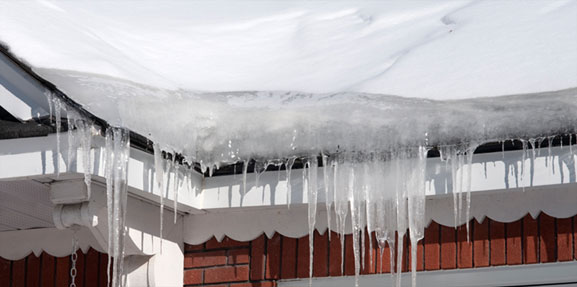How to Prevent Roof Damage from Ice Dams this Winter
by Hoffman Weber Construction, on December 19, 2010
The Midwest has been walloped by snowstorms these last few days. In the wake of these monster snow falls it is important to keep an eye on your roof as these extreme amounts of snow can be troublesome, and ice dams can begin to form as the snow accumulates.
An ice dam is formed on a slanted roof when heat from the attic causes snow on the roof to melt. This water flows down the roof and then freezes when it reaches the edge of the roof where it comes in contact with the colder air. This keeps additional run off from draining off of the roof. The water then builds up behind the ice dam where it can seep under shingles and into the house.
How to Spot an Ice Dam
The tell tale sign of an ice dam is a lot of icicles or a large icicle hanging from the roof. You might also find ice in your gutters or downspouts, which will cause water to back up behind it and into the house.

What Causes an Ice Dam?
Ice dams are caused by heat escaping through your roof and melting the snow sitting on the roof. This heat transfer can occur in 2 ways.
- Conduction. Heat energy travelling through a solid. Heat can escape by travelling through your insulation and then through your roofing materials.
- Convection. Heat energy travelling via the transfer of air. Heated air can escape from inside the home into the attic through openings from light fixtures, recessed lights, and bath fans. Once this heated air reaches the attic it then escapes via conduction through the insulation.
Ice Dam Removal and Prevention
An immediate action you can take to rid your roof of an ice dam is to remove snow from your roof. Exercising extreme caution, use a snow rake to remove snow. Don’t try to chip through any existing ice as this can cause damage to your shingles. For extensive ice damming, it is a good idea to look for roof ice and snow removal services that use steam to remove ice dams.
Or you might give this simple solution a try. Polyester ice melt sleeves are available for purchase, but you can make your own by filling a tube sock or the leg of a pair of panty hose with non-staining calcium chloride chemical ice melt pellets. Do not use salt, as it can stain your roof and siding. Lay the sock over the ice dam so it hangs over the gutter and edge of the roof. In a few hours it will have melted the snow and ice around it which will create a channel for water to flow down. Refill the sock with fresh ice melt chemical approximately every 30 days to ensure the sock's continued effectiveness. You may need to place more than one on your roof to achieve the amount of ice removal you need.
You may also want to consider the following home improvements to prevent ice dams in the long term:
- Make your ceiling airtight. Seal around light fixtures, etc.
- Increase attic insulation. Choose an insulation with a high R-value to reduce heat loss by conduction.
- Improve attic ventilation. Allowing heated air to escape in a controlled manner will help keep the roof colder which will reduce the melting of the snow.





